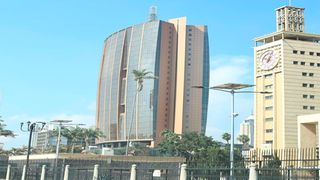
Bunge House and National Assembly in Nairobi on July 9, 2023. The 2023 county allocation bill, currently being considered in the Senate, gives Nairobi the highest share.
| Kennedy Amungo | Nation Media GroupNews
Premium
Revealed: Central counties get lesser allocations despite topping in employment data
What you need to know:
- KNBS data shows that Central Kenya counties with high ratios of employed residents won’t be the top recipients of county cash allocations, lagging in bottom 13.
Five Mt Kenya counties have the highest proportion of working age population in employment, although they are among regions that receive the least county allocations.
Kirinyaga, Nyandarua, Murang’a, Nyeri and Embu recorded the highest employment-to-population ratios of over 73.7 percent, according to a July 4 update of the Kenya National Bureau of Statistics (KNBS) Labour force analytical report.
This is 10 percentage points above the 63.4 percent national average.
Employment-to-population ratio is the proportion of a country’s working age population that is employed.
A high employment-to-population ratio indicates that a large proportion of the working age population is employed.
Employed persons are considered as those who worked for pay or profit, for at least an hour during the reference period (last seven days) or held a job or economic activity but were temporarily absent from work.
It implies that regions with higher employment ratios would have a larger proportion of the population that pays taxes and engages in economic activities that generate revenues.
Bottom 13
However, despite having the majority working-class, Kirinyaga, Nyandarua, Nyeri and Embu are among the bottom 13 recipients when it comes to allocation of the equitable share of revenue among the 47 counties, according to the 2023 County Allocation of Revenue Bill that is before the Senate.
On the cash allocation, Murang’a is, however, at a slightly higher position among the bottom 21.
By contrast, low employment-to-population ratios were recorded in Garissa, Turkana, Mandera, Wajir, Mombasa, Isiolo and Marsabit counties, according to the report based on data from the 2019 Kenya Population and Housing Census.
A low ratio indicates that a large share of the working-age population is not directly engaged in market related economic activities because they are either unemployed or out of the labour force.
However, besides being earmarked to receive among the highest allocations of county cash, these five counties are also among the biggest beneficiaries of the Sh10 billion Equalisation Fund targeting to uplift poor regions.
Lion’s share
Turkana, Mandera and Wajir are third, seventh and 11th among counties set to get the lion’s share of the county allocations.
Garissa, Mombasa and Marsabit are also among the top 24 counties with the biggest allocations, with Isiolo the exception earmarked to receive the fourth least amount.
Although Nairobi’s employment-to-population ratio (59.8 percent) is below the national average, the capital city will get the lion’s share of county allocation (Sh20 billion).
Nakuru, the recipient of the second highest amount (Sh13.6 billion), has an employment-to-population ratio (66 percent) that is slightly above the national average, as does Kakamega (64.7 percent) set to get Sh13 billion, the fourth highest allocation.
Others with the lion’s share of the county allocation with employment ratios slightly above the national average are Kiambu (Sh12.2 billion), Bungoma (Sh11.1 billion), Kitui (Sh10.8 billion) and Meru (Sh10 billion).
Among the outliers is Kilifi with the sixth highest allocation of Sh12.1 billion but with an employment-to-population ratio that is below the national average (59.9 percent).
Kisumu (Sh8.4 billion), with an employment ratio of 60.4 percent is also within this bracket.
The cash is shared out among the counties based on the statutory third basis formula, which takes into account the following factors: population (18%); health index (17%); agriculture (10%); urban (5%); poverty (14%); land area (8%); roads (8%), and basic share index (20%).
Politicians from the populous Mt Kenya have stepped up the campaign to have the formula reviewed using the “one man one shilling one vote” clarion call.
“The debate is premised on the fact that there are regions that are being allocated an average of Sh30, 000 per head while others have Sh3, 000 as their share per head. The disadvantaged regions are not exclusively in Mt Kenya, but also in Bungoma, Homa Bay, Machakos, Kakamega, Kisii, Siaya, Kisumu, Uasin Gishu, Kilifi, Bomet and Kajiado,” Kiambu Governor Kimani Wamatangi said in a recent interview.
“This debate should not be made to appear as beneficial to Mt Kenya region only,” he added.
Working population
The employment-to-population ratio in the rural areas was higher at 66.1 percent compared to urban areas (58.6 percent).
This is despite only a third – 14.8 million – of the country’s 47.6 million by the time living in urban centres, which means the vast majority are in rural areas.
Overall, the total number of persons aged 15-64 years who reported to be working in 2019 were 17 million.
This represented an increase of 19.7 percent from 14.2 million employed persons reported in the 2009 Census.
Nairobi County reported the highest proportion of the employed population at 10.4 per cent followed by Kiambu at 6.1 per cent.
Lamu county (0.3 percent) and Isiolo (0.4 percent) reported the lowest proportion of the employed population.
Nationally, the average working hours of all employed persons was 45.3 hours per week.
However, males on average worked longer hours (47.7 hours) per week compared to females (42.9 percent per week).
The employed population in urban areas worked for a relatively longer time of 50.8 hours per week compared to those in the rural areas who worked for an average of 42.7 hours per week.
Employed persons in Nairobi and Mombasa counties recorded the highest average working hours per week of 51.4 hours each.
Working population in West Pokot and Garissa counties had the lowest average working hours at 33.4 hours per week each.





